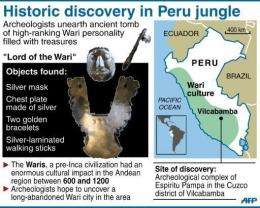Ancient Peruvian site forces experts to re-think past

Archeologists have discovered a group of ancient tombs in the mountainous jungle of southeastern Peru they say is as important as the discovery of the lost city of Machu Picchu.
The tombs belonging to the Wari culture were found on the jungle-covered eastern slope of the Andes in Cuzco department at a long-abandoned city thought to be the last redoubt of Inca resistance to Spanish colonial rule.
The Waris, a pre-Inca civilization, had an enormous cultural impact in the Andean region between 600 and 1200. The Inca empire (around 1400 to 1532) was the largest pre-Columbian empire in the Americas.
"It is an impressive Wari find in the Cuzco jungle that opens a new chapter on archaeological research and forces us to re-write history," said Juan Garcia, the cultural director for the Cuzco region, as he announced the discovery late Wednesday.
"The discovery is one of the most important ever, and is comparable to Machu Picchu... and the Lord of Sipan," said Garcia, referring to the 1987 discovery of the tomb of an ancient Moche lord.
Archaeologists found a y-shaped silver chest plate, a silver mask, two golden bracelets with feline figures and two wooden walking sticks laminated with silver in the tomb of a high-ranking personality dubbed the Lord of Wari.
The tombs are within the archaeological complex of Espiritu Pampa, in the Cuzco district of Vilcabamba, some 1,100 kilometers (680 miles) south-east of Lima.
Vilcabamba was the last refuge of Inca resistance after Spanish conquistadors captured and executed the Inca emperor in 1532. The last resistance leader, Tupac Amaru I, was captured by the Spaniards after fleeing the site and executed in 1572.
It is a "spectacular, truly surprising" discovery, said archaeologist Luis Lumbreras, former director of the National Cultural Institute (INC).
"This will make us revise part of Inca history."
It is the first proof of Wari presence in the jungle, and proof that the Waris were in the area much earlier than the Incas, Lumbreras said.
Archaeologists first found the funeral complex in July 2010, and studied it for the next months.
Lumbreras said he would not be surprised that archaeologists now uncover a Wari city in the area "that may have something to do with legends like that of Paititi."
For centuries, explorers have fruitlessly searched for Paititi, a fabled lost city in the Amazon jungle said to be filled with gold and jewels.
The pre-Columbian civilizations in the Americas left no written record of their history, so it is largely up to archaeologists to describe history before the European contact.
In places like Peru, ancient sites have been well preserved in the dry coastal region and in the Andes, but bones and textiles rarely survive the wet and humid conditions of the jungle.
(c) 2011 AFP




















